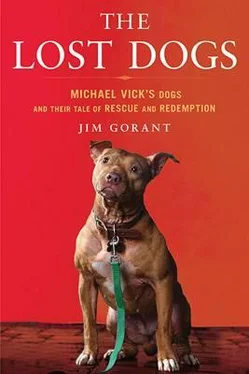Donna Reynolds and Tim Racer liked most of what the ASPCA members proposed but they had their own evaluation system, developed during their ten years working with the breed, especially a four-year period when they were paid to assess all the pit bulls that came through the city shelter in Berkeley, California. It was a hands-on system supplemented by research.
BAD RAP preferred to begin the evaluation at the side of the pen, where they observed the dog’s behavior as it was approached. Did it cower in the corner, approach the gate and sit, wag its tail? Did it jump up and down, did it growl and show teeth? They also liked the “blow test,” which involved lightly blowing in the dog’s face. For whatever reason, they’d found that most pit bulls loved this and took it as an invitation for face-to-face contact, but a more negative or neutral reaction could indicate a dog that was less people-friendly.
Reynolds and Racer also wanted to see each dog interact with not only a fake dog, but with other live dogs, one of each gender. Racer argued that testing with live dogs was more telling of how the Vick dogs would react in the real world. He also favored a “push test,” in which he would start out gently and playfully pushing a dog and build up to the point where he was giving it a good shove that sent it back a few feet to see how it would react. He felt it added a little more certainty about the dog’s demeanor.
In the end, the two approaches were not that far apart and a compromise was easily reached. They would use both live dogs and stuffed dogs in the evaluations. And outside the ASPCA tests, BAD RAP could do their own additional tests, including the blow test and the push test.
In the conference room they went over everything one last time and ran through the assessment sheets that they would use to score each dog. They split into two groups, but they would all go to the first evaluation together, so they could compare notes on their observations and make sure everyone was grading on a coordinated scale. Outside, they ducked into unmarked cars and U.S. marshals whisked them off into the afternoon heat. Dr. Z was hopeful that the good guys would win. After all, they only needed to rescue 10 percent of the victims to save the day.
EARLY THE NEXT MORNING Tim Racer prepared to test the first dog. He was at the Hanover shelter and before him were the eleven dogs that had started out in Surry County before being transferred here. Racer approached a black dog with a white belly that was sitting in the back of an upper-level kennel. If the pup looked familiar to Racer it was because a week earlier the officer in charge of the facility had broken the court’s gag order and let the New York Times and New York Daily News in to see the dogs. The Times had run a large photo of this little fellow, with his soft eyes and uncertain stare, beneath a headline that read MENACING DOGS FROM VICK CASE AWAIT THEIR FATE.
The media lapse had angered everyone on the case and earned the officer, Kevin Kilgore, a USDA Grade A reaming from Jim Knorr, so on this day Kilgore was being especially helpful. When he saw Racer hesitate before the pen, trying to figure out how to climb up and gently coax the dog out, he offered to help. As Racer remembers, he grabbed a noose pole, a long rod with a retractable loop at the end. It’s usually used to corral animals that show signs of aggression, although it’s sometimes also used during routine operations as a matter of protocol.
No such protocol ruled this day and the dog was, if anything, rather timid, but Kilgore snared him around the neck and lifted him out of the kennel. Racer was horrified as the dog swung from the pole, gagging. He charged forward and caught the little guy in midair. “You know what,” he said, “I don’t need any more help. I’ll get the dogs myself.”
He carried the dog outside and placed him on the pavement. The heat was oppressive, 95 degrees and humid. The dog immediately pancaked flat on the ground. The evaluators ran through the first few tests. Nothing. The dog didn’t move. He absolutely was not aggressive toward people. In fact, he was nonresponsive. Racer continued the tests, as a matter of due diligence and because the team thought it might give them some sort of baseline from which to judge the other dogs.
Chew toys, play games, food-nothing roused the dog. Finally, Racer went back into the shelter. He approached another Vick dog that was friendly and eager to please but not too enthusiastic. He put that dog on a leash and took it outside. As soon as he did, the black dog lying on the ground perked up.
He rose to meet the other dog, his tail wagging. They sniffed each other’s faces and backsides; they began to play a bit. Racer took the test dog back inside and reappeared with a similarly well mannered female dog. The black-and-white dog responded to that one equally well. He was fully engaged now. The opportunity to interact with the other dogs had pulled him out of his shell.
The team reran all the tests, and this time the dog performed well. He wasn’t perfect-he looked at the pull toy like it was an alien ship and he didn’t quite know what to make of the shoving game-but he didn’t react violently. It was clear the dog had a lot to learn, but Racer felt sure that with some work he would make a great house pet and help change people’s minds about pit bulls. As Racer took up the leash and got ready to take the dog back into the shelter, he looked at Reynolds. “We’re one for one,” he said.
The next dog was the little female Racer had used to test the first dog. She looked a lot like the first dog, small and black with white highlights, and she performed even better. She breezed through the tests, and before long Racer was smiling up at Reynolds: “Two for two.”
The next few dogs performed similarly and before Racer even turned to Reynolds and said, “We got our five,” the whole atmosphere of the day had changed. At the start of the morning there had been a notable tension in the air. Everyone expected the worst, and even if they held out a glimmer of hope, they fought to suppress it.
They’d all put down dogs before. None of them liked the task, and it was that much harder if there was any sort of emotional attachment. Better to assume that things wouldn’t work out. Everything they’d heard made them think they had little reason to hope for anything better and that infused the proceedings with a certain “let’s get it over with” sense of resignation.
But as the first dogs went through the battery of tests, the mood lightened. As each dog was led out, the question in the air changed from “What now?” to “Hey, let’s see what we get this time.”

The highlight of the day-one evaluations came before the team left Hanover. Racer approached a large dog with deep scars across his chest. A big guy, he sat at the gate of his kennel, his tail beating a steady rhythm on the floor. As Racer approached, the dog alternately lifted his front feet, as if he were a dancing horse. He stood up and then sat back down. Finally, Racer knelt before his gate. He spoke in a flowing singsong and put his fingers up against the chain link. The scarred dog sniffed and then licked the fingers.
Racer blew in the dog’s face, and he vacuumed up the scent, twitching his nose and moving his snout to and fro as he followed the aroma. He pressed his snout against the gate and tried to lick Racer’s face. As Racer took the dog from the kennel and started walking him across the floor, the scarred dog showed no fear or trepidation, pulling ahead, not even looking at the other dogs that barked and whined around him. He moved straight toward the door at the far side of the room.
Читать дальше













